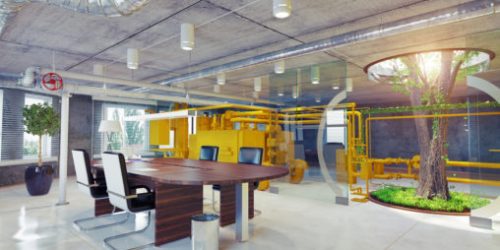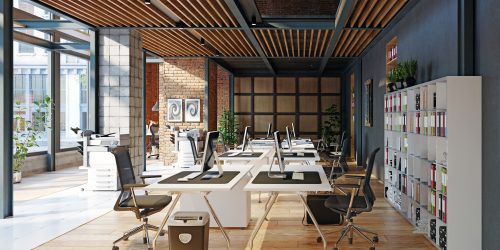What are the ideal desk measurements for a professional workspace?
Choosing the right desk for a professional workspace is a key element to ensure the comfort and productivity of employees. A desk that’s too small will quickly become cluttered and uncomfortable, while an oversized desk will unnecessarily occupy precious space. It is therefore essential to consider several criteria to determine the perfect size for your office desk, depending on your needs and the space available.
Factors to consider before choosing office desk dimensions
When selecting a desk with the right dimensions, several criteria should be considered.
The available space in the room
First and foremost, it is essential to evaluate the available space in the room where the desk and furniture will be installed. Whether it’s in an open-plan office, a dedicated office corner, or a meeting room, the size of the allocated space will directly influence the maximum dimensions possible for your office furniture.
The type of desk: Individual, shared, executive…
The type of desk required will also guide your choice. Is it an individual desk, a computer workstation, a shared workstation, a supplementary desk, or an executive desk? Each configuration requires suitable dimensions to guarantee optimal comfort of use. For example, a meeting table would perfectly fit a co-working space.
The equipment and accessories to be placed on the desk
Another criterion concerns the equipment and accessories you wish to place on your desktop:
- Computer;
- Monitor(s);
- Printer;
- Telephone;
- Desk lamp;
List all the essential items for your activity and ensure that the desk size is sufficient to accommodate them without clutter. Don’t forget to allow space for documents and storage, such as drawers or pedestals to be integrated under the desktop.
The user’s preferences and comfort
Lastly, consider the preferences and comfort of the end user. Each employee has specific needs in terms of workspace, depending on their physique, habits, and daily tasks.
Standard dimensions for a professional office desk
When choosing a desk, it is important to refer to the recommended standard desk dimensions to ensure optimal comfort of use.
Length: 120 to 180 cm
As a general rule, a desk varies between 120 and 180 cm in length, left to right, offering a sufficiently spacious work surface to accommodate your equipment and documents.
Depth and width: 60 to 90 cm
Standard desk width usually ranges between 60 and 90 cm front to back. A 60 cm wide desk will be suitable for light office use, while a desk depth of 80 to 90 cm will be more appropriate if you need to accommodate multiple monitors or numerous accessories on the desktop.
Height: 73 to 78 cm
The standard desk height is between 73 and 78 cm, a dimension that suits the majority of users. However, it may be advisable to opt for a height-adjustable desk, which will allow adaptation to different body types and the ability to vary between sitting and standing positions throughout the workday, for better comfort and enhanced ergonomics. This flexibility promotes better ergonomics and helps reduce muscle and joint tension.
Variants for particular configurations
If you have limited space or a particular configuration, there are clever variants to optimise your office spaces. For example, a wooden corner desk can allow you to take advantage of a room corner while benefiting from a large desktop surface. For a co-working space or an open-plan office, a modular meeting table can be an interesting solution to adapt to the different needs of employees.
Don’t forget that the choice of dimensions for a professional desk should also take into account the available space in the room. Carefully measure the area dedicated to the workstation and ensure there is sufficient clearance around the table to move around easily and access storage.
Choosing the right desk dimensions based on the number of monitors
The number of monitors you wish to install on your desk is an essential criterion to consider when choosing the dimensions of your desktop. A space that is too restricted will not allow you to comfortably position your monitors and work under optimal conditions.
Minimum dimensions for use with one monitor
For use with a single monitor, the recommended minimum desk dimension is 120 cm in length and 60 cm in depth. This surface will provide you with enough space to install your monitor, keyboard, and mouse, while leaving a free area for your documents and accessories.
Recommended dimensions for use with two or more monitors
If you need to work with two or more monitors, it is preferable to opt for a more spacious desk, with a minimum length of 140 cm and a depth of 80 cm. This configuration will allow you to position your multiple monitors side by side without feeling cramped and provide a comfortable work surface to spread out your files and take notes.
Optimal positioning of monitors on the desktop
For optimal positioning of monitors on the professional desk, favour an arc-shaped arrangement, with the monitors slightly angled towards the user. This configuration will prevent constant head turning and reduce neck strain. Also, ensure that the monitors are positioned at a comfortable distance from the eyes (about 50 to 70 cm) and adjust their height so that the top of the monitors is at eye level.
If a laptop is regularly used in addition to fixed monitors, reserve a dedicated space on your desktop to place and connect it easily. You can also invest in a docking station for laptops, which will allow you to connect all peripherals in one go and gain in practicality.
Organising the space around the desk
To create a pleasant and functional office space, it is necessary to consider the optimisation of workspace layout and the overall room organisation. Start by evaluating the clearance needed around the desktop to move freely and easily access storage. Ideally, allow at least 80 cm on each side of the desk.
If you have limited space, vertical storage can be a clever solution to free up floor space. Opt for wall shelves, or custom-made storage furniture to organise your documents and office supplies.
Consider integrating decorative elements that promote well-being and concentration, such as potted plants, artwork, or warm lighting. A well-designed desk, with appropriate dimensions and a pleasant environment, will motivate you to spend time in the workspace and contribute to professional fulfilment.
Essential accessories for a functional desk
Beyond finding the right desk dimensions, you should complement it with suitable office accessories to create a truly functional and comfortable workstation:
- Ergonomic office chairs: Opt for an office chair or desk chair with adjustable height for the backrest and seat, for optimal support and maximum comfort, essential for well-being and productivity.
- Desk storage solutions: Invest in drawers and pedestals under the desk, as well as cabinets and shelves to keep your documents and supplies organised and accessible.
- Footrests: They promote good posture and relieve tension in the legs.
- Monitor stands: They allow you to position your monitor at the right height, avoiding neck pain.
- Good lighting: Choose adjustable-intensity desk lamps for targeted lighting and to prevent eye strain.
By judiciously choosing the sizes of your professional desk and integrating it into an overall ergonomic and comfortable layout, you will create a work environment conducive to concentration, productivity, and employee well-being. Every detail counts in designing a functional and pleasant workspace, from the dimensions of your desk to the accessories that accompany it.
Download our whitepaper “Office space design: The guide for healthy and safe work-spaces”.





